Global Market Comments
May 2, 2018
Fiat Lux
Featured Trade:
(TRADING THE U.S. STEEL FIASCO),
(X), (XLI), (TSLA), (BA)
(ANNOUNCING THE MAD HEDGE LAKE TAHOE, NEVADA, CONFERENCE, OCTOBER 26-27, 2018)
(THE COOLEST TOMBSTONE CONTEST)

Global Market Comments
May 2, 2018
Fiat Lux
Featured Trade:
(TRADING THE U.S. STEEL FIASCO),
(X), (XLI), (TSLA), (BA)
(ANNOUNCING THE MAD HEDGE LAKE TAHOE, NEVADA, CONFERENCE, OCTOBER 26-27, 2018)
(THE COOLEST TOMBSTONE CONTEST)

Talk about unintended consequences. Tamper with the free market and it will usually blow up in your face.
You would have thought that U.S. Steel was going to announce blockbuster earnings in the wake of the new 25% steel tariff imposed by the administration, right?
Wrong.
Instead, it has triggered a disaster of epic proportions. The reasons why provide a crash course on how fast the modern economy is evolving.
Of course, the stock market didn't like it, the shares crashing some 17.1% since the announcement. U.S. Steel, far and away the biggest beneficiary of administration policies, is now down on the year.
You may recall that we made a fortune when we bought U.S. Steel last summer at $21 a share, well before the run up into the passage of the tax package. The shares gained a mind-blowing 127%.
Not only did the company deliver a shocking disappointment on Q1 earnings, bringing in net profits of only 10 cents a share, it guided lower for Q2. Expectations had been far higher. Still, that is far better than the $180 million loss it brought in a year ago.
The CEO, David Burritt, cited unexpected "operational volatility." Take that to mean the chaos created by the steel tariffs. There is also trouble with its Great Lakes factory.
Flat rolled steel used to manufacture cars swung from an $88 million loss to a $23 million profit. But tubular steel used for pipelines incurred a $23 million loss.
What is really amazing is that the company made only a dime per share off an increase in total steel shipments YOY of 15.6%. Clearly, there is trouble in Pittsburgh.
And here is what U.S. Steel didn't expect. Instead of paying the extra 25% for imported steel, many customers are simply designing steel out of their products to cut costs rather than shifting to (X).
Three decades ago, this might have taken years to achieve. Thanks to advanced software applications this can now be accomplished in weeks. Companies are vastly more sensitive to costs than they were only a few years ago, and mere pennies can make all the difference.
It's only a matter of time before the entire auto industry shifts to carbon fiber, which has four times the strength of steel at one fifth the weight. That gives you a 20X improvement in performance and safety. Cost and mass manufacturing are the only issues.
Tesla (TSLA) is planning to make the jump in a couple of years. Boeing (BA) and the U.S. Air Force already have.
Where is U.S. Steel in a carbon fiber world? Try Chapter 11.
In the meantime, U.S. Steel consumers are scrambling to get exemptions from the punitive tariffs, creating a bureaucratic nightmare for all involved.
Wilber Ross's Commerce Department has been flooded with some 3,500 requests, each one of which takes months to review. The agency has boosted staff, but it is still overwhelmed. It looks like the only new American jobs the tariff will create will be government ones.
It turns out that many types of high grade steel, such as for razor blades and specialized carbon steel parts, aren't made in the U.S.
To prove that I learn something new every day, I discovered that even France is an important steel supplier. And I thought it was all about wine, cheese, and those cute black berets.
The net result for consumers has been uncertainty in the extreme. That purgatory has just been extended with the government's 30-day postponement of the tariffs announced yesterday.
If companies wait long enough the tariffs will simply disappear. They will certainly be declared illegal by the World Trade Organization.
The national security rationale for the steel tariffs was always completely bogus and will be laughed out of court. If steel really were a national security issue the Defense Department would have its own steel mill, as it already does with semiconductors.
The chips in U.S. weapons systems are 100% made in the USA to keep foreign back doors out of the design process.
Wars of the future will be bought with software, not M1 Abrams tanks or battleships. If fact, they already are.
As for the shares of U.S. Steel, I'm not touching them here. If the economic data continues to weaken as it has, you don't want to be anywhere near this sector.
The stock market already has reached that conclusion.
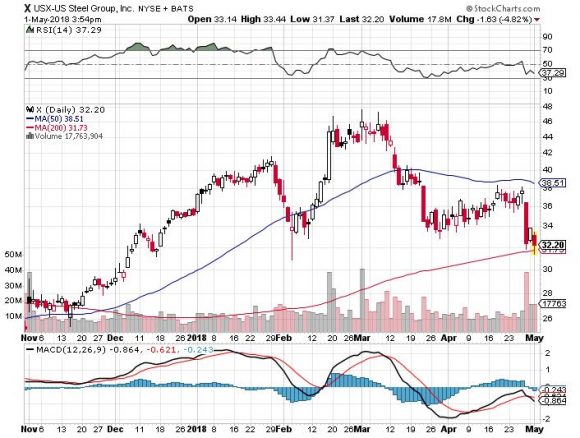
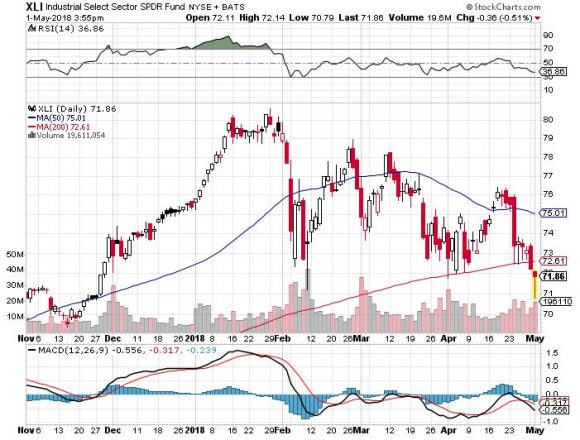
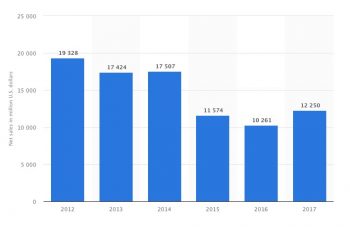

On the USS Missouri; Made in the USA
Tickets for the Mad Hedge Lake Tahoe Conference are selling briskly. If you want to obtain a ticket that includes a dinner with John Thomas and Arthur Henry you better get your order in soon.
The conference date has been set for Friday and Saturday, October 26-27.
Come learn from the greatest trading minds in the markets for a day of discussion about making money in the current challenging conditions.
How soon will the next bear market start and the recession that inevitably follows?
How will guarantee you retirement in these tumultuous times?
What will destroy the economy first, rising interest rates or a trade war?
Who will tell you what to buy at the next market bottom?
John Thomas is a 50-year market veteran and is the CEO and publisher of the Diary of a Mad Hedge Fund Trader. John will give you a laser-like focus on the best-performing asset classes, sectors, and individual companies of the coming months, years, and decades. John covers stocks, options, and ETFs. He delivers your one-stop global view.
Arthur Henry is the author of the Mad Hedge Technology Letter. He is a seasoned technology analyst, and speaks four Asian languages fluently. He will provide insights into the most important investment sector of our generation.
The event will be held at a five-star resort and casino on the pristine shores of Lake Tahoe in Incline Village, NV, the precise location of which will be emailed to you with your ticket purchase combination.
It will include a full breakfast on arrival, a sit-down lunch, coffee break. The wine served will be from the best Napa Valley vineyards.
Come rub shoulders with some of the savviest individual investors in the business, trade investment ideas, and learn the secrets of the trading masters.
Ticket Prices
Copper Ticket - $599: Saturday conference all day on October 27, with buffet breakfast, lunch, and coffee break, with no accommodations provided
Silver Ticket - $1,299: Two nights of double occupancy accommodation for October 26 & 27, Saturday conference all day with buffet breakfast, lunch and coffee break
Gold Ticket - $1,499: Two nights of double occupancy accommodation for October 26 & 27, Saturday conference all day with buffet breakfast, lunch, and coffee break, and an October 26, 7:00 PM Friday night VIP Dinner with John Thomas
Platinum Ticket - $1,499: Two nights of double occupancy accommodation for October 26 & 27, Saturday conference all day with buffet breakfast, lunch, and coffee break, and an October 27, 7:00 PM Saturday night VIP Dinner with John Thomas
Diamond Ticket - $1,799: Two nights of double occupancy accommodation for October 26 & 27, Saturday conference all day with buffet breakfast, lunch, and coffee break, an October 26, 7:00 PM Friday night VIP Dinner with John Thomas, AND an October 27, 7:00 PM Saturday night VIP Dinner with John Thomas
Schedule of Events
Friday, October 26, 7:00 PM
7:00 PM - Exclusive dinner with John Thomas and Arthur Henry for 12 in a private room at a five-star hotel for gold and diamond ticket holders only
Saturday, October 27, 8:00 AM
8:00 AM - Breakfast for all guests
9:00 AM - Speaker 1: Arthur Henry - Mad Hedge Technology Letter editor Arthur Henry gives the 30,000-foot view on investing in technology stocks
10:00 AM - Speaker 2: Brad Barnes of Entruity Wealth on "An Introduction to Dynamic Risk Management for Individuals"
11:00 AM - Speaker 3: John Thomas - An all-asset class global view for the year ahead
12:00 PM - Lunch
1:30 PM - Speaker 4: Arthur Henry - Mad Hedge Technology Letter editor on the five best technology stocks to buy today
2:30 PM - Speaker 5: John Triantafelow of Renaissance Wealth Management
3:30 PM - Speaker 6: John Thomas
4:30-6:00 PM - Closing: Cocktail reception and open group discussions
7:00 PM - Exclusive dinner with John Thomas for 12 in a private room at a five-star hotel for Platinum or Diamond ticket holders only
To purchase tickets click: CONFERENCE.

"We have not been investing this year, we have been on a battleground," said noted UK hedge fund manager Crispin Odey.

Global Market Comments
May 1, 2018
Fiat Lux
Featured Trade:
(FRIDAY, JUNE 15, 2018, DENVER, CO, GLOBAL STRATEGY LUNCHEON)
(ANATOMY OF A GREAT TRADE)
(TLT), (TBT), (SPY), (GLD), (USO),
(CYBERSECURITY IS ONLY JUST GETTING STARTED),
(PANW), (HACK), (FEYE), (CSCO), (FTNT), (JNPR), (CIBR)

So, I'm sitting here agonizing over whether I should sell short the US Treasury bond market (TLT) once again.
Thanks to the bombshell Israel announced today alleging the existence of a secret Iranian nuclear missile program, oil has rallied by 2%, the US dollar has soared, and stocks have been crushed.
The (TLT) has popped smartly, some $2.5 points off of last week's low, taking yields down from a four-year high at 3.03% down to 2.93%.
The report is probably based on false intelligence, which is becoming a regular thing in the Middle East. Suffice it to say that the presenter, Prime Minister Benjamin "Bibi" Netanyahu, may soon be indicted on corruption charges. Clearly, they are going "American" in the Holy Land.
But for today, the market believes it.
You can understand me chomping at the bit, as selling short US government bonds has been my new rich uncle since the market last peaked in July 2017.
I just ran my Trade Alert history over the past nine months and here is what I found.
I sent you 38 Trade Alerts to sell short bonds generating 18 round trips, AND EVERY SINGLE ONE WAS PROFITABLE! In total these Alerts generated a trading profit of 216%, or 21.62% of my total portfolio return.
That means 35% of my profits over the past year came from selling short Treasuries.
You should do the same.
Falling Treasury prices have been one of the few sustainable trends in financial markets during the past year.
Stock rallied, then gave up a chunk. Gold (GLD) has gone nowhere. Only oil has surpassed as a sustainable trade, thanks to successful OPEC production quotas, which have been extended multiple times.
Texas tea is up an admirable 67% since the June $42 low. And who was loading up on crude way down there?
Absolutely no one.
Of course, I have an unfair advantage as a bond trader, as I have been doing this for nearly 50 years.
I caught the big inflation driven fixed income collapse during the 1970s, which had a major assist then from a rapidly devaluing US dollar.
That's when they brought out zero-coupon bonds, effectively increasing our leverage by 500% for virtually no cost. Principal only strips followed, another license to bring money on the short side.
The big lesson from trading this market for a half century is that trends last for a really long time. The bull market in bonds that started in 1982, when 10-year yields hit 14%, lasted for 33 years.
As we are less than three years into the current bear market the opportunities are rife. We are very early into the new game. This one could last for the rest of my life.
The reasons are quite simple. The fundamentals demand it.
1) The Global Synchronized Recovery is accelerating.
2) The Fed will start dropping on the bond market in the very near future $6 billion a month, or $200 million a day, worth of paper in its QE unwind.
3) Tax cuts will provide further stimulus for the US economy.
4) With the foreign exchange markets now laser-focused on America's exploding deficits, a weak US dollar has triggered a capital flight out of the US.
5) We also now have evidence that China has started to dump its massive $1 trillion in US Treasury bond holdings.
All are HUGELY bond negative.
All of this should take bonds down to new 2018 lows. What we could be seeing here is the setting up for the perfect head and shoulders top of the (TLT) for 2018.
As for that next Trade Alert, I think I'll hold out for a better price to sell again. What's the point in spoiling a perforce record?
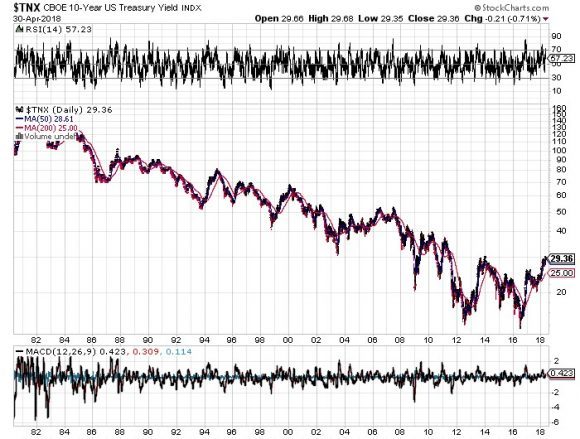
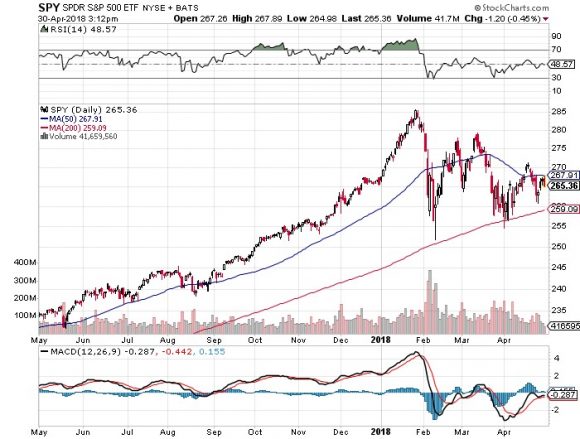
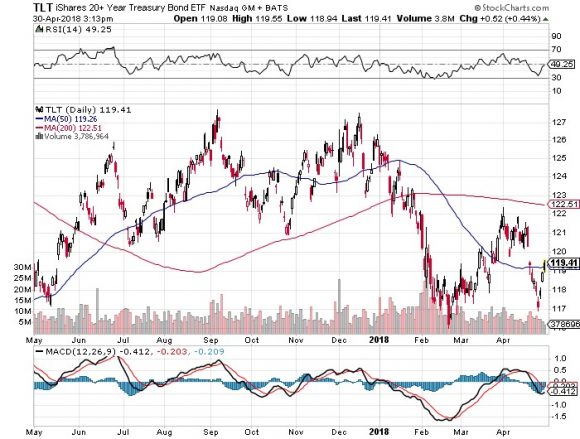
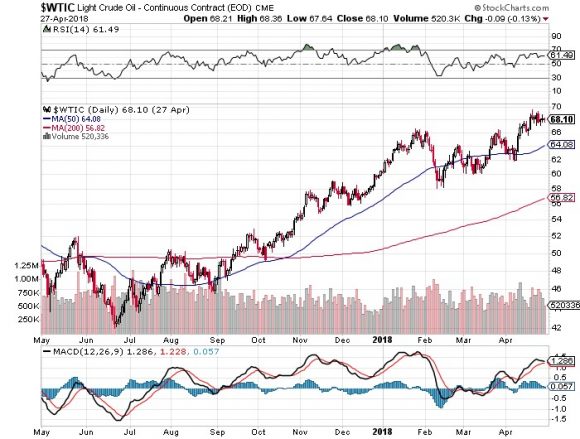

Time to Stick to Your Guns
Global Market Comments
April 30, 2018
Fiat Lux
Featured Trade:
(FRIDAY, JUNE 15, 2018, DENVER, CO, GLOBAL STRATEGY LUNCHEON)
(THE MARKET OUTLOOK FOR THE WEEK AHEAD, or I HATE IT WHEN I'M RIGHT!)

Come join me for lunch at the Mad Hedge Fund Trader's Global Strategy Update, which I will be conducting in Denver, CO, on Friday, June 15, 2018. An excellent meal will be followed by a wide-ranging discussion and an extended question-and-answer period.
I'll be giving you my up-to-date view on stocks, bonds, currencies, commodities, precious metals, and real estate. And to keep you in suspense, I'll be throwing a few surprises out there, too. Tickets are available for $228.
I'll be arriving at 11:30 AM, and leaving late in case anyone wants to have a one-on-one discussion, or just sit around and chew the fat about the financial markets.
The lunch will be held at an exclusive downtown private club. The precise location will be emailed with your purchase confirmation.
I look forward to meeting you and thank you for supporting my research.
To purchase a ticket, please click here.

"We are in the ninth year of an economic expansion and the ninth year of a bull market. Investors are at a crossroads now, whether to hold cash or stocks," said Tom Lee, cofounder of Fundstrat Global Advisors.

Featured Trade:

Legal Disclaimer
There is a very high degree of risk involved in trading. Past results are not indicative of future returns. MadHedgeFundTrader.com and all individuals affiliated with this site assume no responsibilities for your trading and investment results. The indicators, strategies, columns, articles and all other features are for educational purposes only and should not be construed as investment advice. Information for futures trading observations are obtained from sources believed to be reliable, but we do not warrant its completeness or accuracy, or warrant any results from the use of the information. Your use of the trading observations is entirely at your own risk and it is your sole responsibility to evaluate the accuracy, completeness and usefulness of the information. You must assess the risk of any trade with your broker and make your own independent decisions regarding any securities mentioned herein. Affiliates of MadHedgeFundTrader.com may have a position or effect transactions in the securities described herein (or options thereon) and/or otherwise employ trading strategies that may be consistent or inconsistent with the provided strategies.
This site uses cookies. By continuing to browse the site, you are agreeing to our use of cookies.
OKLearn moreWe may request cookies to be set on your device. We use cookies to let us know when you visit our websites, how you interact with us, to enrich your user experience, and to customize your relationship with our website.
Click on the different category headings to find out more. You can also change some of your preferences. Note that blocking some types of cookies may impact your experience on our websites and the services we are able to offer.
These cookies are strictly necessary to provide you with services available through our website and to use some of its features.
Because these cookies are strictly necessary to deliver the website, refuseing them will have impact how our site functions. You always can block or delete cookies by changing your browser settings and force blocking all cookies on this website. But this will always prompt you to accept/refuse cookies when revisiting our site.
We fully respect if you want to refuse cookies but to avoid asking you again and again kindly allow us to store a cookie for that. You are free to opt out any time or opt in for other cookies to get a better experience. If you refuse cookies we will remove all set cookies in our domain.
We provide you with a list of stored cookies on your computer in our domain so you can check what we stored. Due to security reasons we are not able to show or modify cookies from other domains. You can check these in your browser security settings.
These cookies collect information that is used either in aggregate form to help us understand how our website is being used or how effective our marketing campaigns are, or to help us customize our website and application for you in order to enhance your experience.
If you do not want that we track your visist to our site you can disable tracking in your browser here:
We also use different external services like Google Webfonts, Google Maps, and external Video providers. Since these providers may collect personal data like your IP address we allow you to block them here. Please be aware that this might heavily reduce the functionality and appearance of our site. Changes will take effect once you reload the page.
Google Webfont Settings:
Google Map Settings:
Vimeo and Youtube video embeds:
